
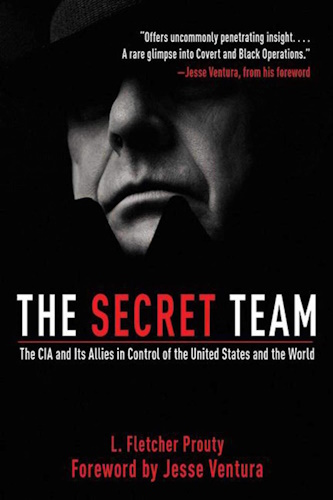
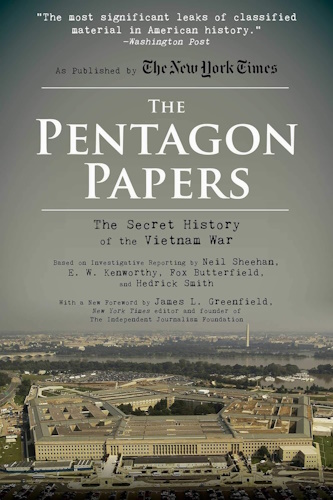

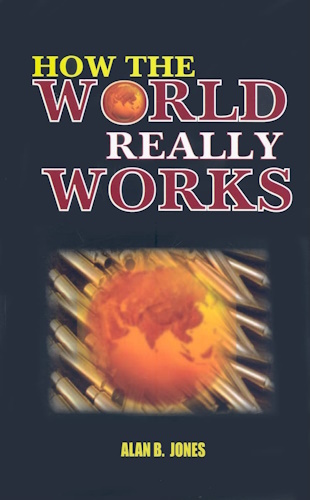

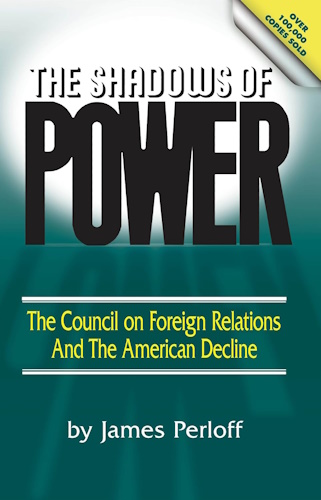

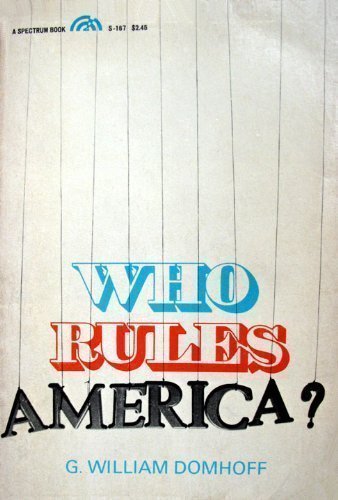

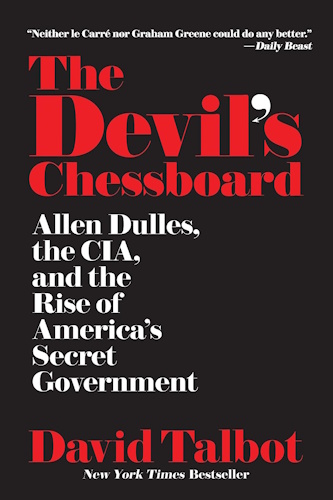
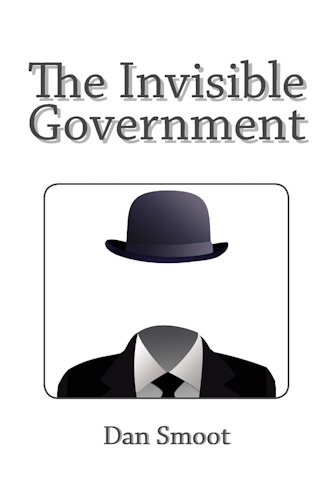

![]()
![]()
PART IV
THE CIA: SOME EXAMPLES
THROUGHOUT THE WORLD
Chapter 21
Time of Covert Action:
U-2 to the Kennedy Inaugural
THERE WAS NO NEED FOR POST-MORTEMS. THE great crusade was dead. There would be no thaw in the Cold War. Pressures that had lain dormant while the world waited and prayed for the success of the summit conference broke out more violently than before: in Japan where Jim Haggerty, the President's press secretary and advance man for his trip, was mobbed outside the Tokyo International Airport; in the Congo where Dag Hammarskjöld was to die violently; in Cuba, and especially in U.S.-USSR relationships. The ST moved fast and quietly. Its operators in many of the MAP countries and in other peripheral areas stepped up their activities. Trouble spots, such as countries suffering from crop failures, border disputes, and terrorization by bandits were given particular attention. What had been a lull before the summit now became a ground swell before the storm.
Eisenhower put out an immediate order that there would be no more overflights anywhere at anytime. This brought to an end, for the time being, the U-2 program, the Cuban exile overflight para-drop program, the vast Tibetan project that was entirely dependent upon long-range transport infiltration, and others of lesser merit. But it did not bring about an end to clandestine activity. It simply drove it deeper under cover right here in the United States. By that time so much was going on all over the world that curtailing overflights had only a small impact upon the rest. The ST muffled its more elaborate operations and began to put all its eggs into one basket -- the move to counterinsurgency operations in the counterinsurgency-list countries.
More than fourteen thousand Tibetans and remote area tribesmen, nearly all of the active population of Tibet above the high Himalayas, had been armed, equipped, and fed by the Agency. This flow of equipment and activity stopped abruptly with Eisenhower's order. These valiant men were left to their own devices in their hostile homeland. They have, no doubt, been rounded up and many of them slaughtered. All of the equipment destined for them was held at CIA supply points in Okinawa, Taiwan, Thailand, and Laos. The Indonesian campaign, which had ended the year before, had resulted in a windfall of leftover military supplies and aircraft, which were sent to Taiwan, Thailand, the Philippines, Laos, and Okinawa. The Cuban program became less visible and more political. It continued to gather together in strategic locations massive stockpiles of aircraft, armament, and shipping. All of this was being held in readiness in storage in Florida, Guatemala, Panama, and Puerto Rico. As a result, the Eisenhower order, if anything, served to strengthen the operational side of the Agency and place it in a position of being able to move fast with ready equipment and personnel as soon as the Administration changed. That was only six months away; so the ST prepared.
All of this preparation and readiness served to underscore how farsighted and how determined the Agency had been in planning within its own sanctum for its role as leader of the Cold War response mechanism. Whereas its Intelligence chieftains received public accolades for work well done, and its Special Operations (DD/P) agents and operators worked as quietly as they could behind the scenes, none of them were more successful than those of Logistics (DD/S), with emphasis on the men in the comptrollership and budget offices. Somewhere in the early days one of these men, or perhaps one of their friends in the legal division, where Larry Houston has held sway for so many years, observed the special applicability of an old law from the depression days -- the National Economy Act of 1932.
For the CIA it has been the big end of the horn of plenty. In layman's language this act states that if one department or agency of the U.S. Government has something which it would like to get rid of, and another agency of the government would like to buy it, then the two agencies are authorized to get together and agree on a buying and selling price to their mutual satisfaction. The sale would be consummated under the terms of the National Economy Act of 1932. The uses to which this expedient can be put to use are infinite and what the agency can do with a few dollars and a few good cover units would in most cases be unbelievable to the uninitiated.
The National Security Act of 1947 was quite strict with reference to money for the Agency, and in many ways the Congress had shown that it did not want the Agency to get much money and that it believed that one sure way it could keep the CIA out of the covert activities business would be to control and restrict its funds. However, by 1949 Congress relented, and although it did not give the Agency a great deal more money, it had let the barriers down. Ever since that law was promulgated, the CIA has had no trouble at all getting adequate funds. But more important than the dollars the Agency gets is what it can do with those dollars to make them cover all sorts of research, development, procurement, real estate ventures, stockpiles, and anything else money will buy, including tens of thousands of people who do not show on any official rosters.
For example: The CIA Act of 1949 says the CIA may "transfer to and receive from other government agencies such sums as may be approved by the Office of Management and Budget, for the performance of any functions or activities authorized . . . and any other government agency is authorized to transfer or receive from the agency such sums without regard to any provisions of law limiting or prohibiting transfers between appropriations. Sums transferred to the agency in accordance with this paragraph may be expended for the purposes and under the authority . . . of this title without regard to limitations of appropriations from which transferred."
Such procedures give the CIA an open hand to move funds in and out of other accounts freely. Of course, the language of this law mentions "activities authorized" and such other normal controlling terms. However, under high classification few people know that this is going on, and few want to become involved even if they find out. Also, the Agency works long and hard to get its own people, or entirely sympathetic people, into the key jobs where such things as this take place, and they see that the controls of the law do not bind at any point.
Years ago, in the headquarters of the Air Force there used to be a fine old gentleman in the budget office who had been there ever since the cement in the Pentagon was wet. He knew as much about the intricacies of the Federal budget as any man in Washington. He had previously worked with Jesse Jones in the Reconstruction Finance Corporation during the old days of the Roosevelt Administration. Somehow he had been assigned the job of handling all of the CIA money that flowed through the Air Force, and he did this with more zeal and élan than any of the actual Agency men "across the river".1 He had in his area of operation a younger and most capable assistant who learned the trade from him. As the years passed, this second man was promoted into the highest budget assignment in the Pentagon, where he served under Robert McNamara, who knew all of the intricacies of the CIA money management, and who saw to it that things always went smoothly. In the case of both of these exemplary public servants, they did their work efficiently and smoothly, and one of their greatest common achievements was that they never let any of these unusual money matters create friction, irregularities, or publicity. Whenever things got to the point just before the boil, they knew how to raise the flag of "security", and the subject would be dropped quietly. This process is one of the key elements in the success of the CIA in matters pertaining to money.
It is possible to read the unclassified Public Law on National Security closely, and by careful interpretation, one can see a lot more there than one might see the first time through. By 1959-60 the Agency was able to count on a great deal of money and upon even more tangible things that its money could buy at considerable savings. There were no barriers then to becoming involved in much greater action, and the stage was set for the political moves that would make it possible.
While elements of the ST were keeping Cuban plans alive, other elements were working on the political resurgence of the U.S. Army. Maxwell Taylor had published his book, The Uncertain Trumpet, and announced his new National Military Plan of Flexible Response. The plan itself did not so much advocate a new military system as it opposed the system that existed. He made light of the "massive retaliation" doctrine of John Foster Dulles, which was the mainstay of the Eisenhower defense posture. Taylor proposed that the United States be ready to respond anywhere in the world with whatever it would take to defeat the "Communist-inspired subversive insurgency", which he felt lay all around us. His plan was a totally passive and defensive stand, based upon one word, one idea and one strategy - response. It was the embodiment of the idea of "containment" one stage removed from the proposals of Clark Clifford.
With the Taylor proposal as a rallying call, the ST began to rekindle and rebuild the Army Special Forces along new lines. The Special Forces were being turned away from war planning activity and MAP support to an active role against subversive insurgency in the countries of the Free World. This was called "flexible response", but at least in the initial stages, it was direct clandestine intervention by U.S. Armed Forces in other countries.
The Agency and certain other of its close friends obtained the Civil Affairs school curriculum from Fort Gordon, and working with that as a foundation, rewrote it into the new U.S. Army Special Forces doctrine and course outline. These words, which sounded reasonable for the training and indoctrination of selected foreign troops, took on an entirely new meaning and significance when they were taught as part of the doctrine of the U.S. Army. This political-social-economic role for the Army was a far departure from the historic indoctrination of the military forces of a free nation.
Work on this activity took place in the last half of 1960 and was ready for initial action before Kennedy was inaugurated. The timing was important, and it was very cleverly arranged. Ordinarily, any major policy change and curriculum change in the Special Forces school at Fort Bragg would have been processed through the Continental Army Command at Fort Monroe, Virginia -- the next higher headquarters. However, this new curriculum was not shown to the Continental Army Command. It was brought to the attention of certain selected ClA-oriented officers of the Army headquarters in the Pentagon so that they might obtain a certain de facto blessing from the civilian top echelons of the Army on the premise that it had been duly and properly "staffed". Then this curriculum was taken directly to Fort Bragg and placed in the hands of selected instructors, some of whom were Agency personnel on cover assignments. They worked rapidly to get an instructor-group trained and ready for the first classes, to be given during December and January of 1960-61. Then, in a very opportune move, the CIA and its friends in the office of the Secretary of Defense set up a visit for the Secretary of Defense to this school. The ostensible purpose of this visit was to enlist his support for the Special Forces who, it was said, needed a morale boost after years of neglect. (Actually, this was made to appear to be the Secretary's formal dedication and approval of this new curriculum and the resurgence of the Green Berets.)
The Secretary of Defense was unable to make this trip, but in his place he designated his most experienced and able deputy, James Douglas. He flew to Fort Bragg to see the rejuvenated Special Forces and the school where Green Beret volunteers and foreign students from all over the world were attending classes featuring the new curriculum.
Mr. Douglas found the Green Berets on the firing range with special light weapons. He saw them practicing with one of the most famous and most lethal weapons, the long bow. Special Forces troopers excelled with the ancient weapon. Others were in outdoor classrooms, learning how to use mines and other explosives for sabotage and demolitions work. Still others were listening to foreign instructors, learning a selected vocabulary of foreign words in the languages of Laos, the Congo, or in Spanish. Then he went into formal classrooms where the U.S. military instructors were lecturing to large classes of U.S. students, into other classes where the students were all foreign, and into still others where foreign and American students attended classes together. This was a stirring sight to the Secretary. He had no way of knowing that as he went from front door to front door a number of students were being hastily shuttled out the back door from classroom to classroom to fill every class he witnessed. The whole scene was polished and fleshed out to a high degree of reality and perfection.
Everywhere in the Special Forces sector of Fort Bragg there was new life and new spirit. The camp was alive and most impressive and convincing. He could not have known that some of those instructors had never seen their notes and lesson guides before that day, and he could not have known that many of the foreign students had been rounded up for that visit, were not enrolled in the school, and had not the slightest idea of what was taking place. He had no way of knowing that the curriculum and the whole show that he had witnessed were part of a major plan to help create the future forces needed by the ST and by the new "flexible response" doctrine of the U.S. Army. What he was doing was participating in the "Selling of the Pentagon" -- 1960 style. He was seeing the resurgence of the Special Forces, a resurgence that would involve the active employment of U.S. military personnel in clandestine activities throughout the world. In other words, the Army would be operating under the direction of the CIA in overseas areas such as Laos and Vietnam, Thailand and Latin America. The course of events had, since 1947, run full circle. Whereas it had been visualized and contemplated that the CIA might be used as a sort of fourth force in the event of active employment of U.S. forces under the direction of the military commander, now it was the military establishment that was furnishing forces to the CIA to serve under the operational control and direction of the CIA in the covert activities of the Cold War.
When he returned to Washington, Mr. Douglas approved what he had seen and authorized a modest expansion of the Army Special Forces. At a time when the Army had reached its lowest man power levels in two decades, this was a significant event. The Green Berets were looking for new fields to conquer. Their victory over the bureaucracy was celebrated throughout the Army, and there was a special quiet elation among the ST. They were on their way. From the date of the U-2 disaster, the ST had become the dominant force within the Government of the United States, in terms of foreign policy and military affairs short of all-out nuclear war. (That proviso is added only because it has not yet been tried, not so much because it is beyond possibility.)
Men from the Special Forces were sent to Panama and Guatemala to train Cubans for the ST. Others went to Eglin Air Force Base in Florida to work with the Air Force Special Air Warfare units in their supporting mission on behalf of the Cuban program. The Air Force, not to be outdone by the Army, had leaped into the special warfare business with special aircraft and with the Air Commandos. Although they saw conflict on several fronts in the offing, at that time they were all working on the Cuban program. During the political campaign, President Eisenhower had directed that the Cuban operations should come to a halt. He wanted nothing under way during the remaining portion of his Administration to be left for the incoming Administration to perform. The over-the-beach projects were halted, and the somewhat regular overflight para-drop projects were stopped. The Cubans did not accept this quietly, and to keep them occupied, their training program was maintained at a good pace.
Other Special Forces troops were sent into Laos as advisers to work with the Meo tribesmen and with other groups who were fighting with the national forces against the Pathet Lao. For some time the skirmishes in Laos far outweighed anything going on in Vietnam or Thailand in size and scope. United States support was shifted from one strongman to another faster than the army could keep up with it. On many occasions British, Canadian, Philippine, and other than French foreign nationals were brought in to work with this undercover army. The CIA had all sorts of units working there. Air units were mercenaries, "covered" U.S. Air Force, Chinese Nationalists, and Thailand air force personnel. This was the place where the CIA first employed helicopter forces of considerable size. The years in Laos were formative years for the CIA and all of the forces that later became engaged with it in Southeast Asia.
Once the military forces began to get a regular taste of this sort of action, certain elements of the military, such as the Special Forces, went to great lengths to excel their mentors, the CIA, in the pursuit of secret operations. This operational activity gave birth to staff cells back in higher headquarters, such as at CINCPAC in Hawaii and in the service headquarters in the Pentagon. In the beginning this was relatively informal; but as time and experience were gained they became hard-core operational centers, such as the famous SACSA of Kennedy-era fame.
These forces saw action all over the world. No matter where the action arose, the same group of men and the same equipment and tactics went into action. The Air Force was given the assignment of flying into the Congo in support of the Kasavubu government. Meanwhile, the ST had put together an air armada of heavy transport aircraft, along with other mercenary units, to aid the Katanga cause on the other side. In Latin America the Special Forces -- both Army and Air Force -- were working closely with many countries and were teaching them to act positively and swiftly against rebel elements in remote areas. None of these early experiences were too noteworthy, but they were evidence of things to come.
In previous years, everything the CIA had done had been carefully cloaked in secrecy to avoid detection. Also, the operations of the Agency had been kept small in order that they would be easier to keep secret. However, since the U-2 program the ST had become less and less concerned with security in overseas areas, as long as they could maintain a measure of security within our own government. Secrecy was maintained very closely here, and very few people in government knew what the Team was doing; but overseas the very existence of powerful operations, even though they were generally clandestine, gave evidence of the strong and stealthy hand of the CIA. This was particularly true of the impending Cuban program. The activity in Panama, in Nicaragua, and Guatemala, and the heightened activity in and around Miami and New Orleans could not be kept secret. Anyone who cared to know, knew that something was under way.
In October 1960, just before the election, Castro charged the United States with aerial aggression. It was true that despite the stand-down directed by Eisenhower, a special interpretation was given for overflights manned by Cuban exiles and to flights from non-U.S. bases. Therefore it was considered by the ST not to be a violation of the President's orders to perform such operational flights from Guatemala to Cuba with para-drops of supplies and ammunition for "supposed" reception parties in Cuba. Few of these flights ever accomplished anything of real value. However, they did much to keep the morale of the volatile Cuban community in the United States from collapsing. Then, on October 30, less than one week before the election, Castro warned his people and the world that the United States was planning and preparing an invasion of Cuba. There can be no question of the fact that Kennedy's stand on the Cuban issues in the campaign and especially on the television debates played heavily in his appeal to many voters, who felt that the country should take a direct course of action against Castro. Therefore, Castro's announcement did little to hurt Kennedy and may have just about finished Nixon's chances of salvaging any votes from the anti-Castro sentiment that ran high in the voting public. John F. Kennedy had foreclosed that issue.
The votes were no sooner counted than the ST began a major buildup of the Cuban program. What had always been known as an airdrop and over-the-beach program now began to be called an invasion. Where hundreds of Cubans had been in training, suddenly the numbers leaped to the thousands, and the camps were filled with Cubans who had volunteered at the recruiting stations in Miami, in New Orleans, and other points.
The heavy logistics elements began to converge on shipping points in North Carolina and Florida, and airlift material was sent down to Guatemala and Nicaragua. The invasion operators in the Agency saw no restraints with the new Kennedy team coming in that January. Eisenhower made no more moves to limit their action, and they felt that they had Kennedy's tacit approval, or would have as soon as he got a full briefing. All they needed to know was that he would not stop them. Allen Dulles fully briefed the President-elect late in November, and at about that time, Kennedy announced that he would retain Allen Dulles and J. Edgar Hoover as his DCI and FBI director. In moves that may have had some significance later, Edward G. Lansdale left Washington for a long time and was known to be in Saigon with President Diem. Walt Rostow and Jerry Weisner went to Moscow for lengthy visits, before coming back to take up senior positions in the Kennedy Administration. Then, shortly after Robert McNamara was announced as the new Secretary Of Defense-designate, he took up offices in the Pentagon and assembled a small staff who began immediately to accustom themselves to their environment. Most of them had seldom if ever been in the Pentagon before.
While this transition was under way, the ST was moving rapidly with its new concepts and policies. The school at Fort Bragg was being rapidly expanded, and at the many MAAC headquarters all over the world the planned training program for civic action began to be implemented. New troubles broke out in Laos, and things began to look very grave there. There had been a brief attempt to overthrow Ngo Dinh Diem in Saigon. Cuba asked the UN to investigate imminent military aggression against itself by the United States. After a brief recount of votes in Hawaii the official tabulation of votes in the Presidential race was announced as 34,221,531 for Kennedy and 34,108,474 for Richard Nixon. It was the closest election in history. The ST may not have elected Kennedy, but they had defeated Nixon. This had been their objective ever since 1958.
Even before the inauguration Washington, official and non-official, began to realize that the most important turnover of Presidential power since the arrival of Franklin D. Roosevelt was under way. The Kennedy team had been together for more than two years. They had worked, fought, plotted, and hoped for the election of their man. In the heat of that long battle they had learned not only to dislike the Eisenhower Administration and all that it stood for, they had learned to hate it. In most instances, as they approached Washington and assembled in their new offices they were not so sure what they planned to do. But they were very sure of one thing if it had been done by the Eisenhower Administration, it was going to be changed.
As the Kennedy Administration settled into their official chairs, some of them were selected to hear about the Cuban invasion plans, and some were not. The first big move was ready to come on stage. The ST was ready to show the Kennedy Administration how things would be done from that time on for the future.
Footnotes
1. When the CIA was housed in World War II temporary buildings in the Foggy Bottom and Reflecting Pool part of Washington, the Pentagon was "across the river" from the CIA. Thus, it had a special meaning to both organizations.












-
Urantia Book, 44:0.11 - The Celestial Artisans
Never in your long ascendancy will you lose the power to recognize your associates of former existences. Always, as you ascend inward in the scale of life, will you retain the ability to recognize and fraternize with the fellow beings of your previous and lower levels of experience. Each new translation or resurrection will add one more group of spirit beings to your vision range without in the least depriving you of the ability to recognize your friends and fellows of former estates.
-
Princess Bride 1987 Wallace Shawn (Vizzini) and Mandy Patinkin (Inigo Montoya)
Vizzini: HE DIDN'T FALL? INCONCEIVABLE.
Inigo Montoya: You keep using that word. I do not think it means what you think it means. -
Urantia Book, 117:4.14 - The Finite God
And here is mystery: The more closely man approaches God through love, the greater the reality -- actuality -- of that man. The more man withdraws from God, the more nearly he approaches nonreality -- cessation of existence. When man consecrates his will to the doing of the Father's will, when man gives God all that he has, then does God make that man more than he is.
-
Urantia Book, 167:7.4 - The Talk About Angels
"And do you not remember that I said to you once before that, if you had your spiritual eyes anointed, you would then see the heavens opened and behold the angels of God ascending and descending? It is by the ministry of the angels that one world may be kept in touch with other worlds, for have I not repeatedly told you that I have other sheep not of this fold?"
-
Urantia Book, Foreword - 0:12.12 - The Trinities
But we know that there dwells within the human mind a fragment of God, and that there sojourns with the human soul the Spirit of Truth; and we further know that these spirit forces conspire to enable material man to grasp the reality of spiritual values and to comprehend the philosophy of universe meanings. But even more certainly we know that these spirits of the Divine Presence are able to assist man in the spiritual appropriation of all truth contributory to the enhancement of the ever-progressing reality of personal religious experience—God-consciousness.
-
Urantia Book, 1:4.3 - The Mystery Of God
When you are through down here, when your course has been run in temporary form on earth, when your trial trip in the flesh is finished, when the dust that composes the mortal tabernacle "returns to the earth whence it came"; then, it is revealed, the indwelling "Spirit shall return to God who gave it." There sojourns within each moral being of this planet a fragment of God, a part and parcel of divinity. It is not yet yours by right of possession, but it is designedly intended to be one with you if you survive the mortal existence.
-
Urantia Book, 1:4.1 - The Mystery Of God
And the greatest of all the unfathomable mysteries of God is the phenomenon of the divine indwelling of mortal minds. The manner in which the Universal Father sojourns with the creatures of time is the most profound of all universe mysteries; the divine presence in the mind of man is the mystery of mysteries.
-
Urantia Book, 1:4.6 - The Mystery Of God
To every spirit being and to every mortal creature in every sphere and on every world of the universe of universes, the Universal Father reveals all of his gracious and divine self that can be discerned or comprehended by such spirit beings and by such mortal creatures. God is no respecter of persons, either spiritual or material. The divine presence which any child of the universe enjoys at any given moment is limited only by the capacity of such a creature to receive and to discern the spirit actualities of the supermaterial world.
-
Urantia Book, 11:0.1 - The Eternal Isle Of Paradise
Paradise is the eternal center of the universe of universes and the abiding place of the Universal Father, the Eternal Son, the Infinite Spirit, and their divine co-ordinates and associates. This central Isle is the most gigantic organized body of cosmic reality in all the master universe. Paradise is a material sphere as well as a spiritual abode. All of the intelligent creation of the Universal Father is domiciled on material abodes; hence must the absolute controlling center also be material, literal. And again it should be reiterated that spirit things and spiritual beings are real.
-
Urantia Book, 50:6.4 - Planetary Culture
Culture presupposes quality of mind; culture cannot be enhanced unless mind is elevated. Superior intellect will seek a noble culture and find some way to attain such a goal. Inferior minds will spurn the highest culture even when presented to them ready-made.
-
Urantia Book, 54:1.6 - True And False Liberty
True liberty is the associate of genuine self-respect; false liberty is the consort of self-admiration. True liberty is the fruit of self-control; false liberty, the assumption of self-assertion. Self-control leads to altruistic service; self-admiration tends towards the exploitation of others for the selfish aggrandizement of such a mistaken individual as is willing to sacrifice righteous attainment for the sake of possessing unjust power over his fellow beings.
-
Urantia Book, 54:1.9 - True And False Liberty
How dare the self-willed creature encroach upon the rights of his fellows in the name of personal liberty when the Supreme Rulers of the universe stand back in merciful respect for these prerogatives of will and potentials of personality! No being, in the exercise of his supposed personal liberty, has a right to deprive any other being of those privileges of existence conferred by the Creators and duly respected by all their loyal associates, subordinates, and subjects.
-
Urantia Book, 54:1.8 - True And False Liberty
There is no error greater than that species of self-deception which leads intelligent beings to crave the exercise of power over other beings for the purpose of depriving these persons of their natural liberties. The golden rule of human fairness cries out against all such fraud, unfairness, selfishness, and unrighteousness.



